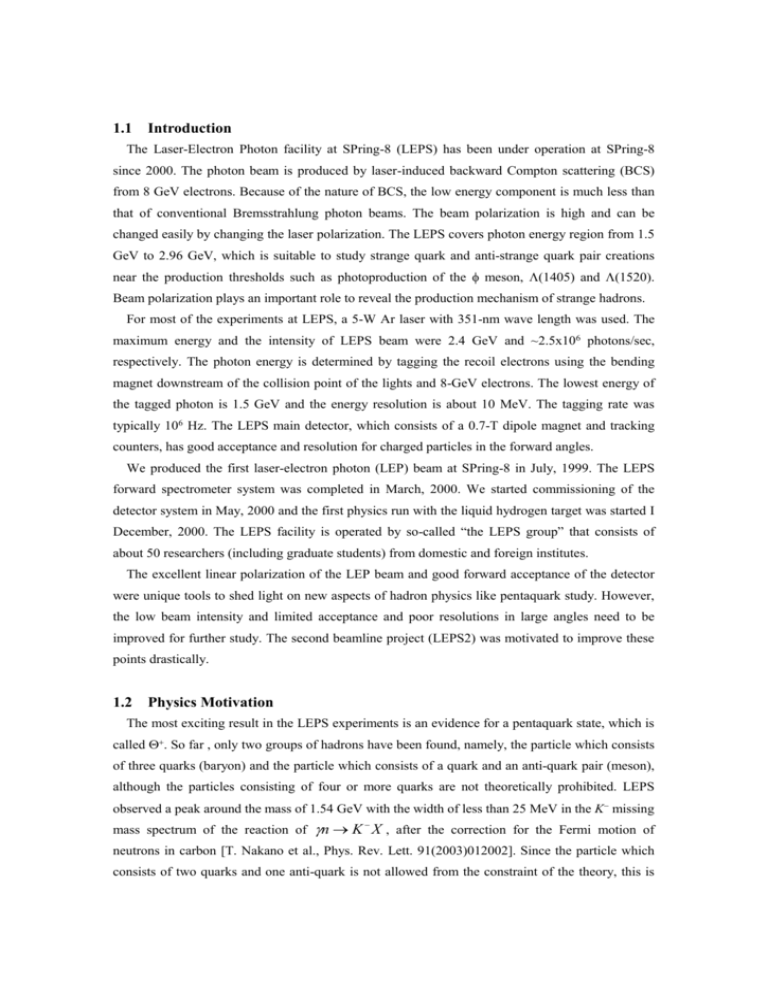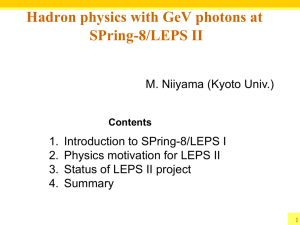A polarized high energy photon beam is produced by laser
advertisement

1.1 Introduction The Laser-Electron Photon facility at SPring-8 (LEPS) has been under operation at SPring-8 since 2000. The photon beam is produced by laser-induced backward Compton scattering (BCS) from 8 GeV electrons. Because of the nature of BCS, the low energy component is much less than that of conventional Bremsstrahlung photon beams. The beam polarization is high and can be changed easily by changing the laser polarization. The LEPS covers photon energy region from 1.5 GeV to 2.96 GeV, which is suitable to study strange quark and anti-strange quark pair creations near the production thresholds such as photoproduction of the meson, (1405) and (1520). Beam polarization plays an important role to reveal the production mechanism of strange hadrons. For most of the experiments at LEPS, a 5-W Ar laser with 351-nm wave length was used. The maximum energy and the intensity of LEPS beam were 2.4 GeV and ~2.5x106 photons/sec, respectively. The photon energy is determined by tagging the recoil electrons using the bending magnet downstream of the collision point of the lights and 8-GeV electrons. The lowest energy of the tagged photon is 1.5 GeV and the energy resolution is about 10 MeV. The tagging rate was typically 106 Hz. The LEPS main detector, which consists of a 0.7-T dipole magnet and tracking counters, has good acceptance and resolution for charged particles in the forward angles. We produced the first laser-electron photon (LEP) beam at SPring-8 in July, 1999. The LEPS forward spectrometer system was completed in March, 2000. We started commissioning of the detector system in May, 2000 and the first physics run with the liquid hydrogen target was started I December, 2000. The LEPS facility is operated by so-called “the LEPS group” that consists of about 50 researchers (including graduate students) from domestic and foreign institutes. The excellent linear polarization of the LEP beam and good forward acceptance of the detector were unique tools to shed light on new aspects of hadron physics like pentaquark study. However, the low beam intensity and limited acceptance and poor resolutions in large angles need to be improved for further study. The second beamline project (LEPS2) was motivated to improve these points drastically. 1.2 Physics Motivation The most exciting result in the LEPS experiments is an evidence for a pentaquark state, which is called . So far , only two groups of hadrons have been found, namely, the particle which consists of three quarks (baryon) and the particle which consists of a quark and an anti-quark pair (meson), although the particles consisting of four or more quarks are not theoretically prohibited. LEPS observed a peak around the mass of 1.54 GeV with the width of less than 25 MeV in the K missing mass spectrum of the reaction of n K X , after the correction for the Fermi motion of neutrons in carbon [T. Nakano et al., Phys. Rev. Lett. 91(2003)012002]. Since the particle which consists of two quarks and one anti-quark is not allowed from the constraint of the theory, this is considered to be a “pentaquark”. Although the LEPS result has seemed to be confirmed by more than a dozen of experiments in other facilities, a lot of negative results have also been reported with good statistics mainly from high energy facilities. Moreover, the recent negative results from CLAS set very stringent upper limits on the photoproduction cross sections of the from the nucleons. Re-measurements of the positive observations with high statistics are highly desirable to clarify the situation. We have continued the search in the new data set using a 15-cm liquid D2 target as well as a liquid H2. They have been analyzed in two reaction modes; a quasi-free process 2-body process n K and a d (1520) . Strong evidences for the were observed in the missing mass distributions of the both reactions. To establish the existence of the , it is necessary not only to repeat the experiments with higher statistics but also to cover wider kinematical regions in terms of both the energy and angle ranges so that we can check if the LEPS and CLAS results are consistent. The high intensity beam and the wide acceptance of LEPS2 will enable us to conclude the issue.











